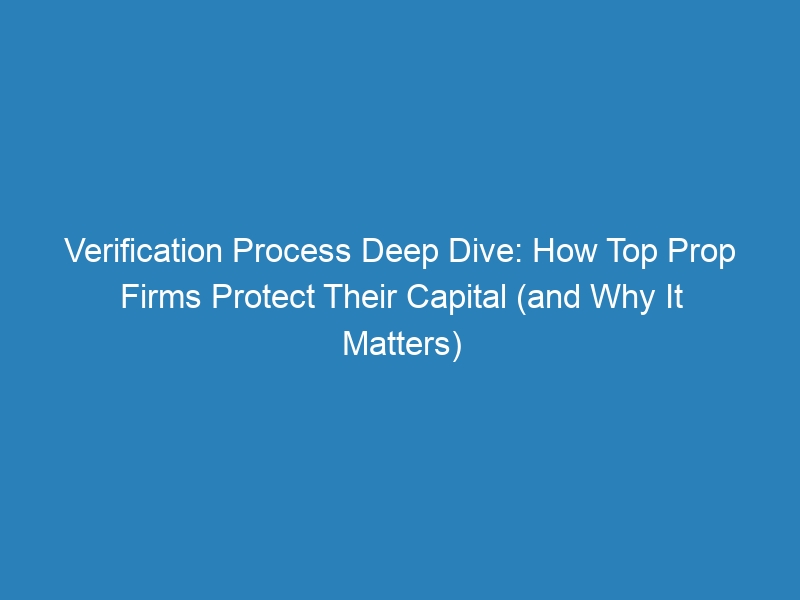Verification Process Deep Dive: How Top Prop Firms Protect Their Capital (and Why It Matters)

In the competitive realm of proprietary trading firms, the verification process serves as a cornerstone for safeguarding capital and minimising risk. This vital process encompasses a range of methods, including thorough background checks and comprehensive financial analyses, which firms employ to ensure that they align themselves with trustworthy traders.
Additionally, the discourse will shed light on common pitfalls to avoid and best practices that pave the way for a successful verification. Grasping these elements is critical for anyone aspiring to thrive in the dynamic trading landscape.
What is Verification Process?
The verification process stands as a pivotal element within the financial ecosystem, particularly for trading and proprietary firms committed to maintaining the highest standards of financial integrity and operational efficiency. This intricate procedure encompasses a variety of activities, including transaction verification, background checks, and financial audits, all designed to ensure that operations comply with established frameworks and regulations.
The verification process is essential in fostering investor confidence, enhancing transparency, and safeguarding against fraud, thus significantly contributing to overall market stability and the protection of investors.
This process establishes a robust framework for risk management, enabling firms to effectively evaluate potential vulnerabilities within their trading operations.
Key steps in this procedure involve thorough data analysis, monitoring of risk assessment metrics, and conducting regular audits to pinpoint discrepancies that could jeopardise financial health. Each step not only mitigates risks but also strengthens investor relations by showcasing a firm’s commitment to ethical practices and financial accountability.
By upholding stringent verification protocols, trading firms can safeguard their capital, attract and retain investors, and maintain their reputations in a fiercely competitive market landscape.
Why Verification Process is Important for Top Prop Firms
For leading proprietary trading firms, the verification process transcends mere regulatory compliance; it serves as a fundamental strategy for capital preservation and risk management, essential for cultivating investor confidence in their operations and investment approaches.
As these firms navigate through the intricacies of market volatility and operational risks, a rigorous verification process becomes critical to their frameworks for risk assessment and performance evaluation.
This dedication to comprehensive verification not only protects investor capital but also enhances the firm’s reputation in a highly competitive trading landscape.
Protecting Capital and Minimising Risk
Protecting capital and minimising risk stand as fundamental objectives within the financial landscape, particularly for proprietary trading firms that engage in diverse trading strategies.
Effective capital protection necessitates the implementation of robust risk management tactics focused on profit preservation, which in turn ensures sustainable trading practices and financial stability. By prioritising these critical elements, firms can significantly enhance their operational efficiency while adeptly navigating market trends and conditions, ultimately fostering improved investor confidence and paving the way for long-term success.
To achieve these ambitious goals, firms employ a variety of trading metrics and financial analysis techniques that facilitate a comprehensive assessment of risk tolerance levels. By meticulously monitoring performance indicators and market movements, they can adeptly adjust their strategies to align with the psychological nuances of trading, ensuring that emotional biases do not intrude upon the decision-making process.
Additionally, employing stop-loss orders and diversifying portfolios emerges as essential practices that fortify risk management efforts. This holistic approach not only strengthens the stability of their capital but also cultivates a disciplined trading environment, enabling a proactive response to market volatility and unforeseen economic shifts.
Methods Used in Verification Process
The verification process employs a sophisticated array of techniques and tools meticulously crafted to ensure adherence to regulatory standards while upholding financial integrity within trading firms.
This encompasses thorough financial analysis, strict compliance with established guidelines, and the implementation of robust internal controls that enable effective transaction verification and fraud detection.
By leveraging these methods, firms can significantly enhance their operational efficiency and substantiate their investment capital, ultimately cultivating a culture of transparency and accountability throughout their operations.
Financial and Trading History Analysis
Analysing financial and trading history serves as a crucial component of the verification process, offering valuable insights into an entity’s historical performance and risk exposure. This analysis entails a meticulous examination of historical data, trading metrics, and adherence to operational standards, all aimed at assessing potential risks and guiding informed decisions regarding capital allocation.
By employing advanced financial modelling techniques, organisations can uncover patterns that illuminate trends over time, a necessity for crafting effective trading strategies. The evaluation of trading history give the power tos firms to identify both strengths and weaknesses, thereby enhancing forecasting and strategic planning capabilities.
This comprehensive understanding not only supports rigorous risk assessment but also improves the overall effectiveness of market analysis. Consequently, firms are better equipped to respond proactively to market dynamics, ensuring that their investment decisions are fortified by robust, data-driven insights.
Common Pitfalls in Verification Process
Navigating the verification process presents a series of common pitfalls that can jeopardise compliance and risk management endeavours for trading firms.
These challenges typically stem from insufficient due diligence, neglected background checks, or a failure to adhere to established compliance frameworks.
Such oversights can result in increased risk exposure and potential financial discrepancies. Recognising and addressing these issues is crucial for enhancing operational efficiency and preserving investor trust in the highly competitive trading landscape.
Mistakes to Avoid
During the verification process, certain missteps can significantly undermine financial integrity and risk management protocols, ultimately leading to serious repercussions for trading firms. Common pitfalls include inadequate documentation, neglecting external audits, and failing to recognise the critical importance of comprehensive transaction verification.
These oversights can precipitate substantial fines, tarnish reputations, and invite increased scrutiny from regulatory bodies, making it essential for firms to adopt best practices. For example, implementing meticulous documentation processes not only enhances accuracy but also facilitates future audits.
Regularly scheduled external audits offer an objective evaluation of compliance with established financial standards, thereby minimising the risks associated with fraud or errors.
By prioritising these key elements in the verification process, firms can cultivate a proactive approach to risk mitigation, ensuring compliance while simultaneously bolstering stakeholder confidence.
Best Practices for a Successful Verification Process
Implementing best practices in the verification process is essential for safeguarding financial stability and ensuring compliance within trading firms.
These practices encompass conducting comprehensive financial audits, establishing strong internal controls, and adhering to compliance guidelines that foster transparency and protect investors.
By incorporating these best practices into their operational frameworks, firms can adeptly navigate market challenges and bolster their overall risk management strategies.
Key Factors for Success
Key factors for success in the verification process hinge upon the maintenance of high operational efficiency standards and the cultivation of strong investor relations. These critical elements encompass the implementation of effective risk management strategies, rigorous financial analysis, and ongoing compliance monitoring with trading regulations.
By concentrating on these aspects, firms can establish a reputation for transparency and reliability, thereby bolstering investor confidence and solidifying their market position.
The integration of advanced trading platforms enables firms to analyse market trends with enhanced precision, a necessity for informed strategic planning. Furthermore, establishing clear communication channels with stakeholders and implementing robust feedback mechanisms play a crucial role in aligning services with investor expectations.
By prioritising these key factors, businesses not only elevate their operational excellence but also forge a path towards long-term financial stability, ensuring competitiveness in an ever-evolving marketplace.
Ultimately, these strategies contribute to the creation of a resilient framework that supports sustained growth and fosters valuable investor relationships.
Frequently Asked Questions
What is the verification process for top prop firms?
The verification process for top prop firms involves a thorough examination of a trader’s trading strategy, risk management techniques, and overall market knowledge. This process helps to ensure that only the most skilled and competent traders are given access to the firm’s capital.
Why is the verification process important for top prop firms?
The verification process is crucial for top prop firms because it helps them protect their capital. By thoroughly vetting potential traders, these firms can minimise the risk of losses and maintain profitability.
What are some common elements of the verification process?
Some common elements of the verification process include reviewing trading history, conducting interviews or assessments, and evaluating the trader’s risk management skills. Some firms may also require candidates to complete a simulated trading test.
Do all top prop firms have the same verification process?
No, the verification process can vary between top prop firms. Each firm may have its own unique criteria and procedures for selecting traders. However, the overall goal of protecting capital remains consistent across all top prop firms.
How does the verification process benefit traders?
The verification process can benefit traders by providing them with access to a significant amount of capital and resources. It also serves as a validation of their skills and can boost their reputation in the trading industry.
What happens if a trader does not pass the verification process?
If a trader does not pass the verification process, they may not be able to trade with a top prop firm. However, this does not mean that they cannot continue trading independently or with other firms. It simply means that they may need to further improve their skills and knowledge before attempting to trade with top prop firms again.
Verification Process Deep Dive: How Top Prop Firms Protect Their Capital (and Why It Matters) Closing: A robust verification process protects both the prop firm and its traders. Always prioritize firms that take this aspect seriously while maintaining fairness and transparency. Learn more about real-world verification processes in our BrightFunded review.


Recent Comments